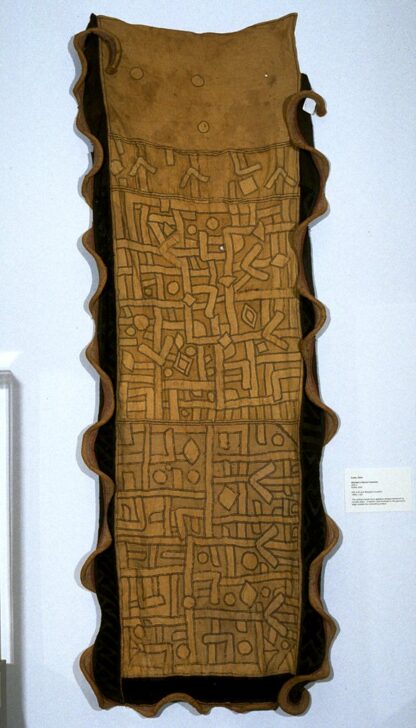Raffia Textile Panel
Kuba

Description
Among the Kuba, the women of the royal court take such raffia cloth as a ground on which to embroider and ornament with appliqued geometrical motifs in order to manufacture 'ntshakishwepi'. These are dance skirts whose use is restricted to the same upper class women. 'ntshakishwepi' have been worn to perform certain ritual dances at court, principally for a dance known as 'itul', but also for other dances in honor of the king. Commoners may wear simple raffia skirts (called 'ntshak') but not embroidered pieces. The designs may, at first sight, appear abstract but, in fact, most motifs had, in the past, meanings and specific names. Their meanings have, however, for the most part been lost, even by members of the royal entourage, and today the noble women merely copy patterns from older 'ntshakishwepi'. Not every panel of each 'ntshakishwepi' is the work of one woman, nor have the individual panels been decorated at the same time. Panels have been added by mothers, grandmothers, friends, and renowned embroiderers.
Subject Matter:
The Kuba peoples are renowned for their elaborate, geometrical surface designs, such as applied to this cloth. Also referred to as cut pile, raffia cloth, Shoowa textile or Kasai velvet (Velours du Kaisai), Kuba cloth is often made from barkcloth: a felt fabric, typically not associated with being a textile because it is not woven. Their plush “velvet” texture, that is particularly seen on the border of this cloth, is achieved through the cut pile technique, where a sharp knife is used to gently clip off the tufts of the palm thread. This particular cloth addititionally consists of the applique technique of adding patches of fabric to hide holes produced by pounding the panel to soften it. The finished textile may be placed in a mortar with cold water and beaten with a smooth, ivory pestle.
In the 19th century, decorated raffia cloth was used as a marker of prestige, as currency, to pay tribute, settle legal disputes, and in public displays such as the funerals of high-ranking titleholders. This particular panel can potentially be an 'ntshakishwepi' which is a ceremonial skirt worn to perform certain dances known as 'itul', but also for other dances in honor of the king. Additionally, they were often used as initiation objects during ceremonial rites of passage. Though barkcloth is the typical fabric, more recently industrial cloth has been used as a replacement.
References:
Monni Adams, Kuba Embroidered Cloth, African Arts, 1978
Daniel Biebuyck, The Arts of Zaire, 1985
Georges Meurant, African Textiles from the Kingdom of Kuba, 1986
Roy Sieber, African Textiles and Decorative Arts, 1972
Physical Description:
Rectangular panel with a tan hem. There is a brown border consisting of a diamond pattern with intersecting lines. The interior design of the panel is tan in color and consists of various appliqued geometric shapes.
Usage Rights:
If you are interested in using an image for a publication, please visit https://umma.umich.edu/request-image/ for more information and to fill out the online Image Rights and Reproductions Request Form.